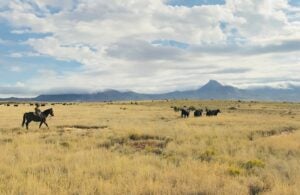With the backing of some advocates in New Mexico, the Biden administration is considering creating its sixth national monument. Yet the movement to designate the Mimbres Peaks National Monument (MPNM) is one that some New Mexico ranchers fear will result in a land grab of 245,000 acres, limiting grazing.
This proposed monument would cover the Florida Mountains, Cooke’s Range, the Good Sight Mountains, and the peaks known as Tres Hermanas in Luna County.
Groups and interests outside Luna County are leading the charge, notably state Sen. Carrie Hamblen, a Democrat from Las Cruces, who also heads the Las Cruces Green Chamber of Commerce. Las Cruces itself is located about 1.5 hours east of the proposed monument.
If designated, Mimbres Peaks would be the second monument established in New Mexico. The first is the 500,000-acre Organ Mountains-Desert Peaks National Monument in Doña Ana County, which conveniently butts up against the proposed boundary for parts of the MPNM.
A campaign without transparency
A campaign was held at the Rockhound State Park near hiking trails in the Florida Mountains on Dec. 6. But none of the area ranchers who hold public land leases in the areas were informed about the meeting.
Days later, permittees received a letter dated Dec. 6 notifying them of the efforts to secure MPNM. Signing the letter were the president of Friend of the Floridas, executive directors of the New Mexico Wildlife Federation, and Friends of the Organ Mountains-Desert Peaks.
Thankfully, ranchers, including Luna County Farm and Livestock Bureau President Russell Johnson, caught wind of a news release on the proposed monument and showed up uninvited to find out what was happening. Then, rather than being invited to group discussions, Dara Parker with Dara Parker Consulting offered to meet with area ranchers individually.
“To me, that’s set up a red flag,” explains Johnson, whose family ranch shares permits with proposed MPNM boundaries at Tres Hermanes. “Why are they trying to meet with people individually instead of meeting as a group so they can put concerns to rest?”
About the time of the Dec. 6 meeting, a new website popped up in support of the MPNM. Johnson says he’s left concerned comments through the platform’s comment link, but he has received no response. AGDAILY also reached out through the platform and has not received a response.

Historical precedents show potential risks in designation
Although the letter that permit holders received assures them that a national monument designation will not impact their grazing allotments, nobody’s convinced. And it’s no wonder.
In a Facebook post, New Mexico Cattle Growers’ President Bronson Corn likened the situation to the Gila Wilderness designation. “Despite promises or even express terms in the enabling language for a national monument designation, traditional uses will be shut down now or in the future,” wrote Corn. “Grazing in the Gila Wilderness, for example, is expressly authorized but is now administratively prohibited. The mobility-impaired and hunters may well find that they are banned from using motorized vehicles in a designated area, thereby limiting their access.”
While national monuments and Wilderness Study Areas, or WSAs, are designated and managed differently, in 2019, a portion of the Organ’s monument was designated as a WSA.
Historically, grazing allotments-turned wilderness areas in the state of New Mexico have restricted leases to the point of burdening ranchers out of the area or have canceled leases altogether even though the Congressional Grazing Guidelines state that “There shall be no curtailments of grazing … simply because an area … has been designated as wilderness.”
»Related: N.M. cattle will likely be spared aerial gunning next year
Why ranchers are concerned about the potential designation
In a recent episode of the District of Conservation podcast, Republican state Rep. Jenifer Jones and miner Lori Coleman, owner of Spanish Stirrup Rock Shop LLC, expressed concerns about the Mimbres Peaks potentially catching Biden’s attention.
Jones noted, “It was a surprise to most people, including all local and state elected officials. Outsiders have proposed the monument, and it was a big surprise. There was no public input before this was launched, including many falsehoods and a lot of information that no one here knew about ahead of time, heavily promoted by outsiders.”
The lawmaker fears that locals, especially those in agricultural and mining industries, might lose access, potentially leading to economic displacement for rural residents who rely on the land.
Some of the ranchers in the area agree. “I think it’s going to impact us by furthering grazing restriction now or later,” said John Bookout, a rancher whose permits include a portion of Cookes Peak. “Eventually, we fear that the lease being qualified as a monument will devalue our ranch.”
Johnson agreed. “No matter what they promise on the front end, the MPNM designation would give the federal government a foothold to further restrictions and even ban grazing. Even if they’re not banning grazing, restrictions could become so burdensome that ranchers can’t make improvements and work on water, making it impossible to manage the land. If you can’t manage it, you can’t properly graze it.”
While potentially impacted ranchers would like to be able to learn from the 2014 designation of the Organ’s management area, Johnson says that ranchers in that management area have been waiting nearly ten years for a resource management plan.
“Organ ranchers are in a holding pattern because the resource management plan hasn’t been developed or implemented. With that in mind, while we have an idea of what’s going to happen, we don’t truly know until the resource management plan is implemented,” explained Johnson.
What is the national monument designation necessary?
State parks and hiking trails already provide access to public land in all four ranges, leading ranchers to ask, why do they need a national monument? And why one of this size?
Under the Antiquities Act, protection is mandated for objects of scientific, historic, or cultural significance on public lands under these designations.
Presidents can create, expand, or reduce monuments within existing federal lands but must confine declarations to the “smallest area compatible with proper care and management of the objects to be protected.”
The Luna County Farm and Livestock Bureau has launched a site designated for comments opposing the MPNM while ranchers await public input meetings.
»Related: Biden’s newest ‘land grab’ may impact Arizona rangelands
Heidi Crnkovic, is the Associate Editor for AGDAILY. She is a New Mexico native with deep-seated roots in the Southwest and a passion for all things agriculture.



